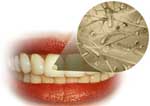 |

Oral Biofilm: Smart Bacteria in Your Mouth, Part 2
Biofilm infections, including those with symptoms of oral malodour, tend to be very persistent because the bacteria in the biofilm can evade the molecules and cells of the immune system. Antibiotics and antimicrobial rinses that would be used successfully on free-floating microorganisms are often not effective against bacteria that are grouped together as a biofilm. Why are biofilms so resistant? Antibiotics such as penicillin are destroyed by the enzymes produced by bacteria in the biofilm so that only the external layer may sustain some damage. The deeper layer of biofilm is not affected. Even chlorine bleach, a highly reactive oxidant, has difficulty in destroying biofilm and burns very slowly through each microscopic layer. Bacteria also can survive in the biofilm because the variety of conditions and bacterial types in the system provides protection against antibacterial agents. It is a case of "united we stand, divided we fall". Bacteria can also form spores so that no amount of antimicrobial therapy will help. When bacteria form spores, they become dead material. The surprising element is that once the conditions are safe, these dead particles or spores come to life again. Even if we manage to kill most of the bacteria in the biofilm, the surviving bacteria can use dead ones as nutrients; the remaining cells can quickly restore the biofilm to its original state in a few hours. Bacteria attached in a biofilm manufacture hundreds of proteins not found in free floating cells. They can support each other nutritionally and often you will find one type producing a chemical as a waste product and its neighbour using the waste product as an essential nutrient. It is a clever way of recycling and also keeping the bacterial biosphere free from toxic products. Certain bacteria within the biofilm have the ability to affect white blood cell functions by interfering with their ability to kill bacteria. These cells lose their phagocytic ability. This means that these white blood cells will not attack bacteria and ignore their presence. Bacteria also attack our white blood cells and can destroy the integrity of these cells through certain enzymes that dissolve proteins and collagen causing the cell walls to disintegrate. Given the complexity of interactions between our cells and the oral bacteria, it is not surprising that the biofilm can cause bad odours, tissue inflammation and even tissue destruction.
|
Copyright © 2006, Anne Bosy. All rights reserved.

